Results 1-7 of 7
<<< Previous 1 Next >>>
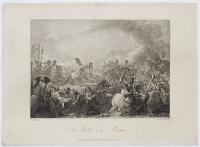
The Battle of the Boyne.
Painted by West. Engraved by J. Grozer.
London: Republished 1. May 1824 by Robert Wilkinson, No. 125 Fenchurch Street.
Rare aquatint with etching. On watermarked paper, 'J. Whatman'. Sheet size: 275 x 375mm (10¾ x 14¾"). Trimmed to platemark. Light creasing and scuffs.
A scene after Benjamin West, depicting William III in the centre, leading his army on horseback as they surge onto the banks of the River Boyne, where, in the lower left corner, the Duke of Schomberg, mortally wounded, is carried by four soldiers. The Battle of the Boyne took place in 1690 between the Catholic James II and the Protestant William III across the River Boyne near the town of Drogheda on the east coast of Ireland, resulting in a victory fo William III.
[Ref: 37321] £140.00
(£168.00 incl.VAT)
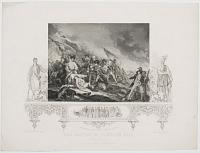
The Battle of Bunker's Hill. June 17th 1775.
Painted by J. Trumbull Esq. Engraved by J. Rogers.
J & F Tallis, London, Eduinburgh and Dublin. [n.d., c.1850.]
Engraving. Sheet size: 205 x 270mm (8 x 10½").
A scene depicting the death of General Joseph Warren at the Battle of Bunker Hill, June 17th 1775, during the American Revolutionary War, within a decorative border showing the surrender of Charlestown to General Clinton below. Warren, an influential Massachusetts politician, had been commissioned a general but served in the battle as a volunteer. He was killed during or shortly after the storming of Breed's Hill by British troops.
[Ref: 37318] £60.00
(£72.00 incl.VAT)
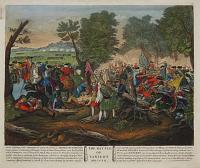
The Battle of Taniers MDCCIX. In the begining of this Campaig his Grace the Duke of Marlborough having made a shew of attaching ye Enemy's Army in their Strong Lines, near La Bassee [...]
[anon., c.1720]
Etching and engraving with hand-colouring, platemark 270 x 330mm (10½ x 13"). Very large margins. Later.
Taniers, better known as Malplaquet, was the bloodiest battle of the eighteenth century, fought during the war of the Spanish Succession (1701-14). The Allies, under Marlborough and Prince Eugene of Savoy, beat the French, but, having 21,000 dead to the French army's 11,000, it was a pyrrhic victory. The losses prompted the English Tory party to begin agitating for a withdrawal from the war.
[Ref: 37021] £240.00
(£288.00 incl.VAT)
![[The Capture of French trophies during the Battle of Waterloo]](img-thumbnail/jpegs/37537.jpg)
[The Capture of French trophies during the Battle of Waterloo] Among the Trophies of the memorable 18th of June the Standard of the 45th and 105th Reg.ts form no inconsiderable feature [...]
J Atkinson del.t. R Ackermann's Lithography [n.d., c.1815]
Lithograph, printed area 210 x 300mm (8¼ x 12").
Print made to commemorate the famous capture of two French standards (those of the 45eme and 105eme de la ligne) during the Seventh Coalition's victory in the Battle of Waterloo. It is not known who captured the eagle of the 45eme (the text here only noting it was taken by Scotch Greys), but Corporal F. Stiles was credited with the capture of the 105eme eagle, as recorded here. Stiles was the only officer rewarded for the capture by being made a sergeant and later given and ensigncy, although competing accounts credit another officer, Captain Alexander Clark, with the capture. The eagle standard of the 105eme is now in the collection of the National Army Museum, London. By John Augustus Atkinson (1775 - 1830), painter, draughtsman and printmaker. He spent 1784-1801 in Russia and subsequently made many prints during the Napoleonic Wars. Following the Battle of Waterloo Atkinson actually visited the battlefield as research for a large painting of the battle (exhibited 1817). The duke of Wellington was one of Atkinson's patrons.
[Ref: 37537] £190.00
(£228.00 incl.VAT)
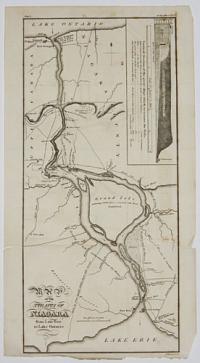
Map of the Straits of Niagara from Lake Erie to Lake Ontario.
H. Mutlow, Sculp.
[London: William James, 1818.]
Engraved map. Sheet 405 x 220mm (16 x 8¾"). Watermarked 'J & M 1817'. Original bind folds, one split.
A near-contemporary map of the War of 1812, published as the frontispiece to William James' 'A Full and Correct Account of the Military Occurrences of the Late War Between Great Britain and the United States'. It marks the Forts Erie, George and Niagara, as well as Buffalo, the Falls, connecting roads, British troop locations and topographical features. An inset shows a cross-section of the Falls.
[Ref: 37391] £320.00
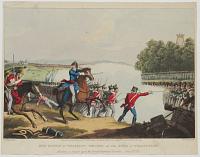
The Battle of Waterloo Decided by the Duke of Wellington, Heading a charge upon the French Imperial Guards, June 18.th. 1815.
J. A. Atkinson Del. M. Dubourg Sculp.
Published & Sold Sep.r.1. 1815 by Edw.d Orme, Publisher to his Majesty & H. R. H. the Prince Regent, Bond Street corner of Brook St London.
Coloured aquatint. Sheet 220 x 285mm (8¾ x 11¼"). Tear taped. Cut inside plate.
Battle scene depicting Wellington's charge on the Imperial Guard. Wellington, mounted upon his horse Copenhagen, calls the charge, brandishing his sword. A figure in a recognisable bicorne hat (perhaps Napoleon) watches the battle from the safety of a platform behind the French line. Wellington's charge, which took place several hours into the Battle of Waterloo, combined with Blücher's attack on Napoleon's right-flank, drove the French troops into disorder allowing the coalition forces to win the day.
[Ref: 37132] £120.00
(£144.00 incl.VAT)
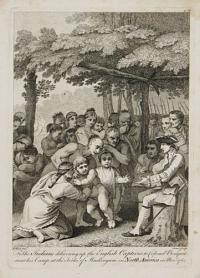
The Indians delivering up the English Captives to Colonel Bouquet near his Camp at the Forks of Muskingum in North America in Nov.r 1764
B. West inv.t. Canot Sculp.
Etching, platemark 230 x 160mm (9 x 6¼"). Large margins.
Engraving after Benjamin West, American-born artist who became President of the Royal Academy. This etching was published in William Smith's 'Historical Account of the Expedition against the Ohio Indians' (1766). Bouquet (1719-65) was successful in striking against the Ohio tribes, and the Shawanese and Delaware sued for terms. Bouquet was made brigadier-general and commandant of all troops in British America's southern colonies, but he died soon after. West's original drawing, dated 1765, is in the Yale Centre for British Art.
[Ref: 37097] £280.00
(£336.00 incl.VAT)
<<< Previous 1 Next >>>



![[The Capture of French trophies during the Battle of Waterloo]](img-thumbnail/jpegs/37537.jpg)


